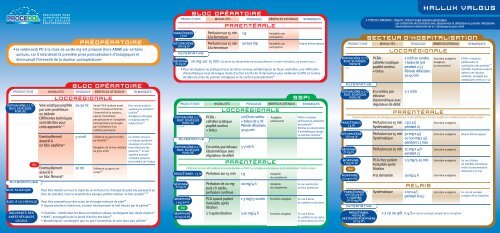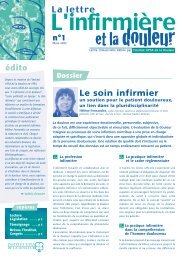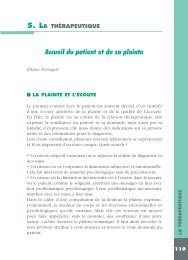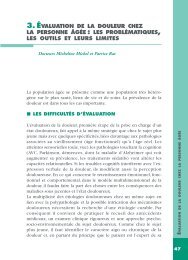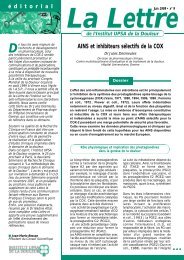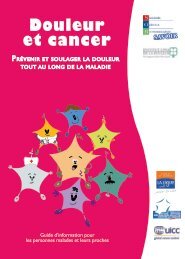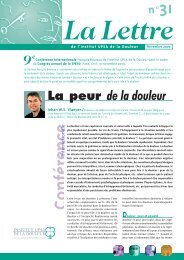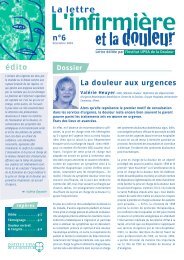Procedol : Hallux valgus - Institut upsa de la douleur
Procedol : Hallux valgus - Institut upsa de la douleur
Procedol : Hallux valgus - Institut upsa de la douleur
You also want an ePaper? Increase the reach of your titles
YUMPU automatically turns print PDFs into web optimized ePapers that Google loves.
PROCEDOL<br />
ropivacaïne 0,5 %<br />
bloc sciatique<br />
poplité<br />
ALTERNATIVES<br />
bloc sciatique<br />
bloc à <strong>la</strong> cheville<br />
adjuvants <strong>de</strong>s<br />
anesthésiques<br />
locaux<br />
5<br />
ou<br />
Voie sciatique poplitée<br />
par voie postérieure<br />
ou <strong>la</strong>térale<br />
Différentes techniques<br />
sont décrites pour<br />
cette approche 6-10<br />
Eventuellement<br />
associé à<br />
un bloc saphène 13<br />
Eventuellement<br />
associé à<br />
un bloc fémoral 13<br />
BLOC OPÉRATOIRE<br />
20-30 ml<br />
5-10 ml<br />
20 ml<br />
PRÉOPÉRATOIRE<br />
• le val<strong>de</strong>coxib PO à <strong>la</strong> dose <strong>de</strong> 40-80 mg est proposé (hors AMM) par certains<br />
auteurs, car il retar<strong>de</strong>rait <strong>la</strong> première prise postopératoire d’antalgiques et<br />
diminuerait l’intensité <strong>de</strong> <strong>la</strong> <strong>douleur</strong> postopératoire 4<br />
PRODUIT/VOIE<br />
PROCÉDURES POUR<br />
LA PRISE EN CHARGE<br />
DE LA DOULEUR<br />
POSTOPÉRATOIRE<br />
MODALITÉS POSOLOGIE BÉNÉFICES ATTENDUS REMARQUES<br />
LOCORÉGIONALE<br />
Seule l’ALR réalisée avant<br />
l'acte chirurgical diminue<br />
l'intensité <strong>de</strong> <strong>la</strong> <strong>douleur</strong>,<br />
assure l’anesthésie<br />
peropératoire et l’analgésie<br />
postopératoire prolongée<br />
par l’utilisation d’un<br />
cathéter périneural<br />
Tolérance au garrot mollet<br />
ou cheville 13<br />
Analgésie <strong>de</strong> <strong>la</strong> face médiale<br />
du gros orteil<br />
Tolérance au garrot <strong>de</strong><br />
cuisse 13<br />
Des concentrations<br />
supérieures semblent<br />
inutiles 11<br />
Analgésie prolongée<br />
vs bupivacaïne et<br />
mépivacaïne 12<br />
Ce <strong>de</strong>rnier procure<br />
un champ opératoire<br />
exsangue et est très<br />
bien toléré par les<br />
patients, 14 le nerf<br />
saphène pouvant<br />
s’étendre jusqu’au<br />
bord médial <strong>de</strong> l’hallux<br />
Peut être réalisé sur tout le trajet <strong>de</strong> ce nerf pour <strong>la</strong> chirurgie du pied (du parasacré au<br />
bloc <strong>de</strong> cheville), mais <strong>la</strong> majorité <strong>de</strong>s équipes préfère réaliser un bloc poplité 15-18<br />
Peut être proposé pour <strong>de</strong>s actes <strong>de</strong> chirurgie mineure du pied 19<br />
Il impose plusieurs injections, souvent douloureuses et mal vécues par le patient 20<br />
• Clonidine : intérêt dans les blocs en injection unique, prolongeant leur durée d’action 21<br />
• AINS : prolongation <strong>de</strong> <strong>la</strong> durée d’action <strong>de</strong>s blocs 22<br />
• Morphiniques : prolongent peu ou pas l’anesthésie, et sont donc peu utilisés 13<br />
kétoprofène<br />
100 mg iv<br />
ALTERNATIVE<br />
néfopam<br />
20 mg iv<br />
PRODUIT/VOIE<br />
paracétamol<br />
1 g iv<br />
BLOC OPÉRATOIRE<br />
Perfusion sur 15 min<br />
à <strong>la</strong> fermeture<br />
Perfusion sur 15 min<br />
à <strong>la</strong> fermeture<br />
1 g<br />
50-100 mg<br />
Analgésie par<br />
anticipation<br />
Analgésie par<br />
anticipation<br />
Risque hémorragique<br />
20 mg sur 15 min à <strong>la</strong> p<strong>la</strong>ce du kétoprofène ou du paracétamol si contre-indication, ou associé aux 2<br />
• Pour les équipes ne pratiquant pas les blocs nerveux périphériques <strong>de</strong> façon routinière, une infiltration<br />
d’anesthésique local <strong>de</strong> longue durée d’action à <strong>la</strong> fin <strong>de</strong> l’intervention peut améliorer <strong>la</strong> DPO en termes<br />
<strong>de</strong> dé<strong>la</strong>i <strong>de</strong> prise du premier antalgique et <strong>de</strong> confort postopératoire 23<br />
ropivacaïne 0,2 %<br />
bloc sciatique<br />
poplité<br />
ALTERNATIVE<br />
ropivacaïne 0,2 %<br />
bloc sciatique<br />
poplité<br />
néfopam<br />
20 mg iv<br />
morphine<br />
1 mg/ml iv<br />
ou<br />
morphine<br />
10 mg/ml sc<br />
3<br />
3<br />
PRODUIT/VOIE<br />
15,17,24<br />
PCRA :<br />
cathéter sciatique<br />
poplité continu<br />
+ bolus<br />
En continu par infuseur<br />
é<strong>la</strong>stomérique avec<br />
régu<strong>la</strong>teur <strong>de</strong> débit<br />
Perfusion sur 15 min<br />
Perfusion <strong>de</strong> 20 mg<br />
puis 1 h après,<br />
perfusion continue<br />
PCA quand patient<br />
évaluable après<br />
titration<br />
2 h après titration<br />
5 ml/h en continu<br />
+ bolus <strong>de</strong> 5 ml<br />
Pério<strong>de</strong> réfractaire:<br />
30-45 min<br />
5-7 ml/h<br />
1 g<br />
20 mg/4 h<br />
1-3 mg/5-10 min<br />
5-10 mg/4 h<br />
Analgésie<br />
satisfaisante<br />
Analgésie<br />
<strong>de</strong> complément<br />
Analgésie<br />
<strong>de</strong> complément<br />
Entretien analgésie<br />
Entretien analgésie<br />
SSPI<br />
PCRA = résultats<br />
performants et satisfaction<br />
<strong>de</strong>s patients 17<br />
Diminue <strong>la</strong> consommation<br />
d’anesthésiques locaux<br />
vs injection continue 17<br />
L‘efficacité du bloc est testée et en cas <strong>de</strong> <strong>douleur</strong> en SSPI, les antalgiques <strong>de</strong> secours sont utilisés dans l’ordre suivant :<br />
paracétamol 1 g iv<br />
MODALITÉS POSOLOGIE BÉNÉFICES ATTENDUS REMARQUES<br />
pARENTÉRALE<br />
MODALITÉS POSOLOGIE BÉNÉFICES ATTENDUS REMARQUES<br />
LOCORÉGIONALE<br />
pARENTÉRALE<br />
Si non administré<br />
au bloc opératoire<br />
En cas d’échec<br />
du cathéter troncu<strong>la</strong>ire<br />
En cas d’échec<br />
du cathéter troncu<strong>la</strong>ire<br />
en alternative à <strong>la</strong> PCA<br />
ropivacaïne 0,2 %<br />
bloc sciatique<br />
poplité<br />
17,24<br />
PRODUIT/VOIE<br />
ALTERNATIVE<br />
ropivacaïne 0,2 %<br />
bloc sciatique<br />
poplité<br />
paracétamol<br />
1 g iv<br />
SECTEUR D’HOSPITALISATION<br />
PCRA :<br />
cathéter sciatique<br />
poplité continu<br />
+ bolus<br />
En continu par<br />
infuseur<br />
é<strong>la</strong>stomérique avec<br />
régu<strong>la</strong>teur <strong>de</strong> débit<br />
Perfusion sur 15 min<br />
Systématique<br />
Perfusion sur 15 min<br />
Systématique<br />
Perfusion sur 15 min<br />
PCA chez patient<br />
évaluable après<br />
titration<br />
A <strong>la</strong> <strong>de</strong>man<strong>de</strong><br />
Systématique<br />
LOCORÉGIONALE<br />
5 ml/h en continu<br />
+ bolus <strong>de</strong> 5ml<br />
pendant 2-3 j<br />
Pério<strong>de</strong> réfractaire :<br />
30-45 min<br />
5-7 ml/h<br />
1 g x 4/j<br />
pendant 2 j<br />
50 mg x 4/j<br />
ou 100 mg x 3/j<br />
pendant 2 j max<br />
20 mg x 4/h<br />
pendant 2 j<br />
1-3 mg/5-10 min<br />
10 mg/4 h<br />
2 cp x 4/j<br />
pendant 8-15 j<br />
Entretien analgésie<br />
Analgésie<br />
au mouvement<br />
Entretien analgésie<br />
Entretien analgésie<br />
Entretien analgésie<br />
Entretien analgésie<br />
Entretien analgésie<br />
Entretien analgésie<br />
PCRA = résultats<br />
performants et<br />
satisfaction <strong>de</strong>s patients 17<br />
Cathéter maintenu jusqu’à<br />
obtenir une <strong>douleur</strong><br />
modérée, sou<strong>la</strong>gée par<br />
antalgiques mineurs (2-3 j)<br />
PARENTÉRALE<br />
Comme précé<strong>de</strong>mment, les antalgiques parentéraux ne sont utilisés que si le bloc poplité est insuffisant et dans l’ordre suivant :<br />
kétoprofène<br />
100 mg iv<br />
néfopam<br />
20 mg iv<br />
morphine<br />
1 mg/ml iv<br />
ou<br />
morphine<br />
10 mg/ml sc<br />
paracétamol<br />
400-500 mg PO<br />
+ codéine<br />
20-30 mg PO<br />
25<br />
ALTERNATIVE<br />
paracétamol<br />
400 mg PO<br />
<strong>de</strong>xtropropoxyphène<br />
30 mg PO<br />
• TYPE DE CHIRURGIE : Objectif : réduire l’angle métatarsopha<strong>la</strong>ngien<br />
- par ostéotomie <strong>de</strong> trans<strong>la</strong>tion avec abaissement et dérotation du premier métatarsien<br />
- éventuellement ostéotomie <strong>de</strong> <strong>la</strong> 1 re pha<strong>la</strong>nge du gros orteil<br />
10<br />
25<br />
RELAIS<br />
HALLUX VALGUS<br />
MODALITÉS POSOLOGIE BÉNÉFICES ATTENDUS REMARQUES<br />
1-2 cp ou gél. x 4/j en cas <strong>de</strong> sevrage complet <strong>de</strong> <strong>la</strong> morphine<br />
Risque hémorragique<br />
En cas d’échec<br />
du cathéter troncu<strong>la</strong>ire<br />
Arrêt si consommation<br />
inférieure à 10 mg<br />
En cas <strong>de</strong> sevrage<br />
complet <strong>de</strong> <strong>la</strong> morphine


